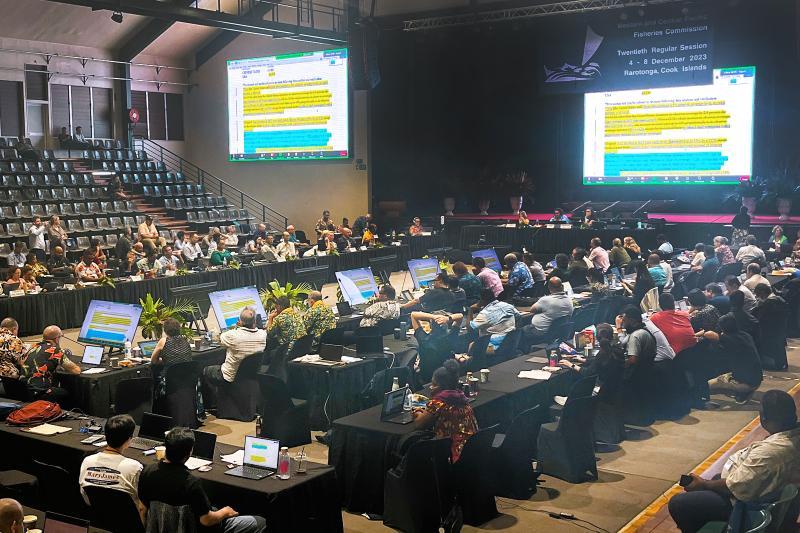
Managing and conserving the world's largest tuna fisheries
by NOAA Fisheries 23 Dec 2023 18:17 UTC

The 20th Annual Western and Central Pacific Fisheries Commission meeting at the Te Are Kariori (National Auditorium) in Rarotonga, Cook Islands © NOAA Fisheries
The 20th Annual Western and Central Pacific Fisheries Commission meeting concluded successfully, with the United States and Pacific nations reaching agreement on many issues.
NOAA Fisheries and partners convened December 4–8, 2023, for the Western and Central Pacific Fisheries Commission annual meeting in the Cook Islands. The aim was to strengthen the conservation and management of international fisheries in the Western and Central Pacific Ocean. Following this gathering, they returned home with new management measures that establish international rules for Pacific bigeye, skipjack, and yellowfin tuna fishing. The agenda topics encompassed discussions on tuna stock status and harvest strategies, as well as the incorporation of climate change considerations into fisheries management.
Meeting Highlights
The United States led the adoption of a measure to create a climate change work plan addressing impacts on fisheries in the Commission Convention Area. The United States and the Republic of the Marshall Islands will co-lead this work plan, and the Commission's Secretariat may also assess current management measures to identify any that may be susceptible to climate change impacts. This will help the Commission be prepared to react quickly and comprehensively to climate change impacts.
The United States also supported several major revisions to the Commission management measure governing the harvest of Pacific bigeye, skipjack, and yellowfin tunas.
Key changes include:
- Support for the Hawai?i-based longline fleet by establishing the U.S. bigeye tuna catch limit at 6,554 metric tons—nearly double the historic limit of 3,554 metric tons
- Support for the U.S. purse seine fleet through reductions in the Fish Aggregating Device closures from 5 months to 2.5 months
- Adoption of three other management measures, including a new Compliance Monitoring Scheme that will enhance compliance with conservation and management measures, and revisions to the management of Pacific Bluefin Tuna and North Pacific Swordfish
"The new measures are critical to supporting sustainable U.S. fisheries in the Western Pacific," said Sarah Malloy, Acting Regional Administrator, NOAA Fisheries Pacific Islands Regional Office. "The United States benefits from sustainable management of tuna stocks, which is essential to the success for our longline and purse seine fleets."
The United States wanted to secure unlimited fishing on the high seas for the U.S. purse seine fleet based in American Samoa. Although it garnered support from numerous members, there wasn't consensus. NOAA Fisheries and other members of the U.S. delegation intend to use the momentum gained at the meeting to continue advocating for the prioritization of support for American Samoa's fishery-based economy.
Collaborating on Change
Adopting these changes was made possible due to the hard work of Commission delegates leading up to the annual meeting.
"The U.S. delegation worked tirelessly throughout 2023 to secure the support of other Commission members for U.S. priorities," said Kelly Kryc, NOAA's Deputy Assistant Secretary for International Fisheries and the head of the delegation to the Commission. "We held multiple bilateral talks, worked closely with Territories and stakeholders, and prepared a variety of working papers detailing the United States' commitment to sustainable fishing and to the fishery development aspirations of the U.S. Pacific Territories."
The U.S. delegation included NOAA, U.S. Pacific Territories, U.S. Coast Guard, State Department, and industry representatives.
NOAA engaged in eight intersessional working groups this year to prepare for the annual meeting. Over the last 2 years, we also provided funding to support three longline fishery management workshops with various Commission members, in an effort to develop a shared vision of the fishery.
With the new measures in hand, NOAA will continue international conservation and management efforts while supporting the economic development aspirations of the U.S. Pacific Territories through:
- Advocacy for the American Samoa-based U.S. purse seine fleet
- Establishment of a harvest strategy for South Pacific albacore tuna
- Development of minimum standards for electronic monitoring
- Agreement to substantively strengthen oversight of at-sea transshipment
- Further enhancement of compliance management measures